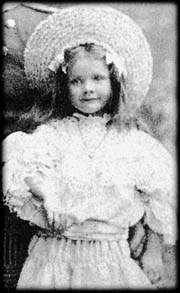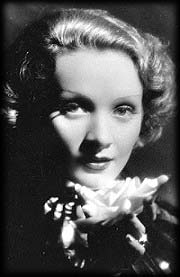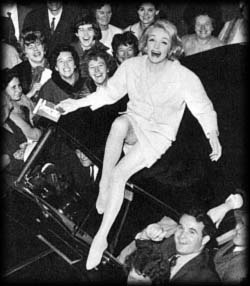-
 also known as: also known as:
- Maria Magdalena Von Losch
- Date of Birth:
- December 27, 1902, Berlin, Germany
- Date of Death:
- May 6, 1992, Paris, France (natural
causes)
- Education:
- Hochschüle fur Musik, Berlin;
Max Reinhardt's Deutsche Theaterschüle
Marlene grew up relying on herself because
her father, an army officer, was serving in the Franco-Prussian War. She was 11 years old
when he died, and her mother married Eduard von Losch. By this time, she found an
enjoyment attending musical concerts and learned to play the violin and piano quite well.
Also within the next few years, Marlene discovered the stage and felt she'd found her
passion in life: acting.
In 1921, Marlene was accepted into an acting school run by
Max Reinhardt. She was able to get her feet wet in acting by appearing
in several stage productions, but nothing major. Therefore, she tried breaking into the
film industry. Starting in 1922, she appeared in two films: Napoleon's Younger Brother
and Tragedy of Love. It was while the filming of Tragedy that Marlene
met Rudolf Sieber, whom she married in 1924. Shortly after marrying, Marlene gave birth to
her only daughter, Maria. Although the marriage lasted up until his death in 1976, they
soon split and remained seperated. get her feet wet in acting by appearing
in several stage productions, but nothing major. Therefore, she tried breaking into the
film industry. Starting in 1922, she appeared in two films: Napoleon's Younger Brother
and Tragedy of Love. It was while the filming of Tragedy that Marlene
met Rudolf Sieber, whom she married in 1924. Shortly after marrying, Marlene gave birth to
her only daughter, Maria. Although the marriage lasted up until his death in 1976, they
soon split and remained seperated.
In 1930, Marlene was given her chance of fame in Hollywood
after being spotted performing in Blue Angel. The first film she did in the
United States was Morocco, with Gary Cooper. In 1931, she
appeared on the silver screen in Dishonored. The film was a success largely for
her performance as a streetwalker who became a spy. Shanghai Express was
next in 1932, which was a big success. All throughout the early thirties, she was typecast
as one kind of character, thus she couldn't expand. Other films followed, but her big
break didn't come again until 1939, when she starred in Destry Rides Again. This
film was important to Marlene, because she was given the chance to play a different type
of character, expanding her ability to act.
 Throughout the early 1940s,
she appeared in quite a few successful films such as Manpower, The Lady is
Willing, and Pittsburgh. She also went on tour and performed for the troops
during World War II in Europe and North Africa. During the later forties and into the
fifties, her film appearances became less and less. In 1961, she obtained a substantial
part in the film, Judgment at Nuremberg. As film appearances declined more and
more, Marlene became more and more involved with stage performances. She sang and danced
in various cities for quite a few years until 1974. Her last film was in 1975 when she
made an appearance in Just a Gigalo. She spent the last twelve years of her life
bed-ridden and out of public. Finally, on May 6, 1992, Marlene died due to liver and
kidney failure in Paris, France. She was 90 years old. She was buried where she was born-
in Berlin, next to her mother. Throughout the early 1940s,
she appeared in quite a few successful films such as Manpower, The Lady is
Willing, and Pittsburgh. She also went on tour and performed for the troops
during World War II in Europe and North Africa. During the later forties and into the
fifties, her film appearances became less and less. In 1961, she obtained a substantial
part in the film, Judgment at Nuremberg. As film appearances declined more and
more, Marlene became more and more involved with stage performances. She sang and danced
in various cities for quite a few years until 1974. Her last film was in 1975 when she
made an appearance in Just a Gigalo. She spent the last twelve years of her life
bed-ridden and out of public. Finally, on May 6, 1992, Marlene died due to liver and
kidney failure in Paris, France. She was 90 years old. She was buried where she was born-
in Berlin, next to her mother.
Interesting
Trivia:
Her estate, consisting of about
300.000 pieces, was bid for 8 mio. german marks by the city of Berlin, Germany.
|
 also known as:
also known as: get her feet wet in acting by appearing
in several stage productions, but nothing major. Therefore, she tried breaking into the
film industry. Starting in 1922, she appeared in two films: Napoleon's Younger Brother
and Tragedy of Love. It was while the filming of Tragedy that Marlene
met Rudolf Sieber, whom she married in 1924. Shortly after marrying, Marlene gave birth to
her only daughter, Maria. Although the marriage lasted up until his death in 1976, they
soon split and remained seperated.
get her feet wet in acting by appearing
in several stage productions, but nothing major. Therefore, she tried breaking into the
film industry. Starting in 1922, she appeared in two films: Napoleon's Younger Brother
and Tragedy of Love. It was while the filming of Tragedy that Marlene
met Rudolf Sieber, whom she married in 1924. Shortly after marrying, Marlene gave birth to
her only daughter, Maria. Although the marriage lasted up until his death in 1976, they
soon split and remained seperated. Throughout the early 1940s,
she appeared in quite a few successful films such as Manpower, The Lady is
Willing, and Pittsburgh. She also went on tour and performed for the troops
during World War II in Europe and North Africa. During the later forties and into the
fifties, her film appearances became less and less. In 1961, she obtained a substantial
part in the film, Judgment at Nuremberg. As film appearances declined more and
more, Marlene became more and more involved with stage performances. She sang and danced
in various cities for quite a few years until 1974. Her last film was in 1975 when she
made an appearance in Just a Gigalo. She spent the last twelve years of her life
bed-ridden and out of public. Finally, on May 6, 1992, Marlene died due to liver and
kidney failure in Paris, France. She was 90 years old. She was buried where she was born-
in Berlin, next to her mother.
Throughout the early 1940s,
she appeared in quite a few successful films such as Manpower, The Lady is
Willing, and Pittsburgh. She also went on tour and performed for the troops
during World War II in Europe and North Africa. During the later forties and into the
fifties, her film appearances became less and less. In 1961, she obtained a substantial
part in the film, Judgment at Nuremberg. As film appearances declined more and
more, Marlene became more and more involved with stage performances. She sang and danced
in various cities for quite a few years until 1974. Her last film was in 1975 when she
made an appearance in Just a Gigalo. She spent the last twelve years of her life
bed-ridden and out of public. Finally, on May 6, 1992, Marlene died due to liver and
kidney failure in Paris, France. She was 90 years old. She was buried where she was born-
in Berlin, next to her mother.